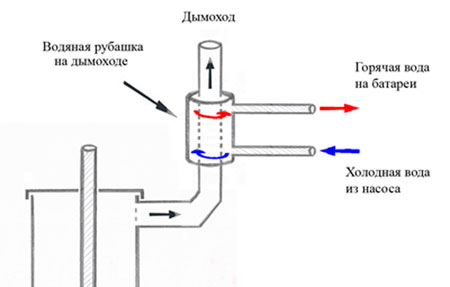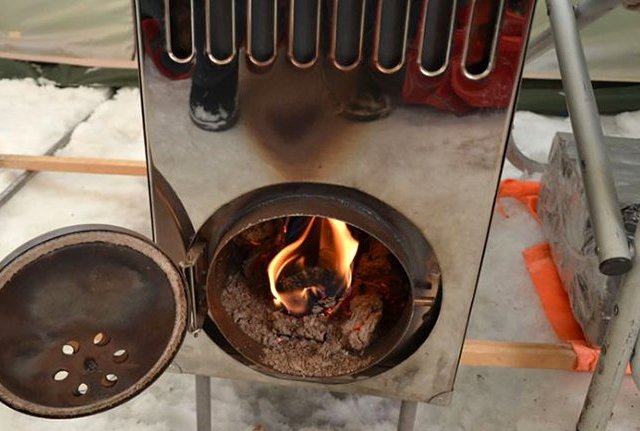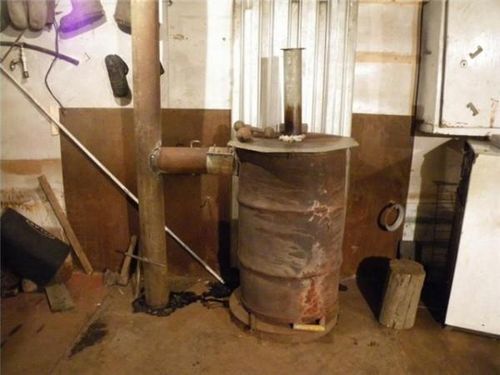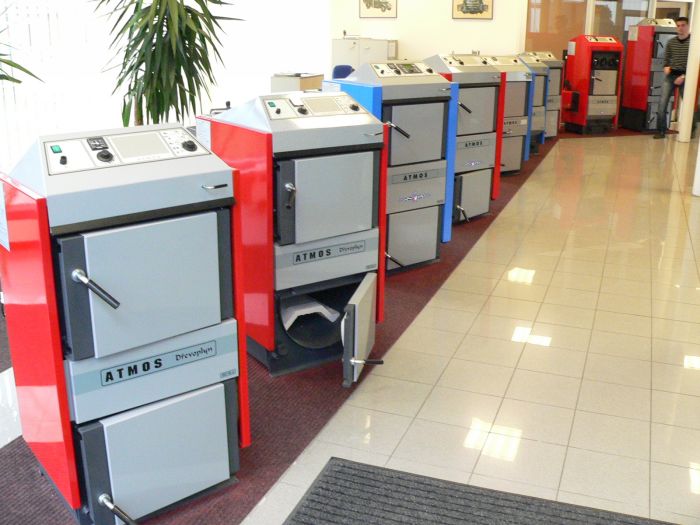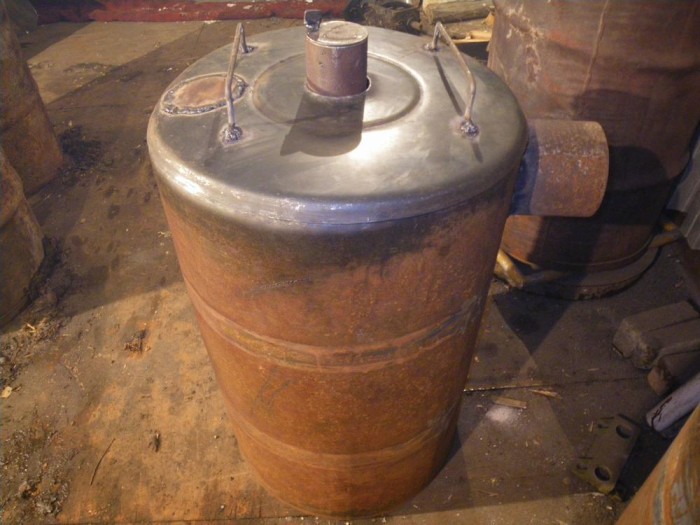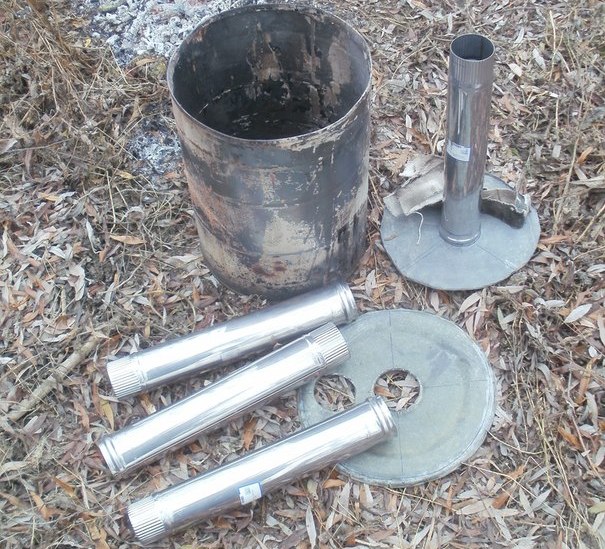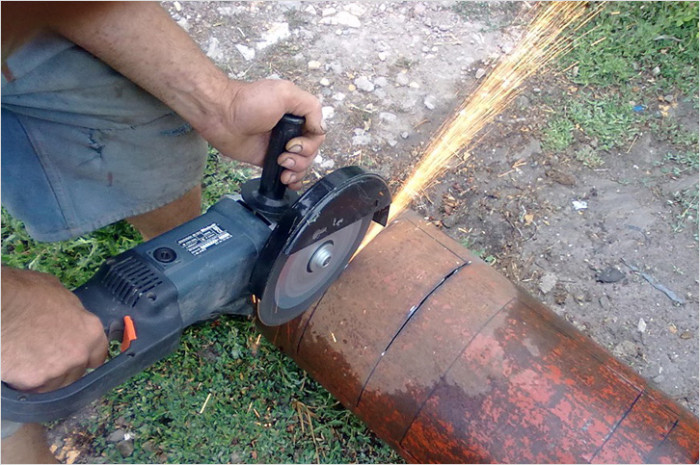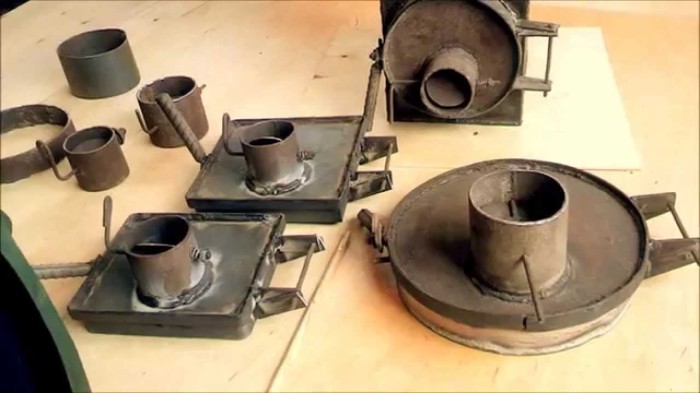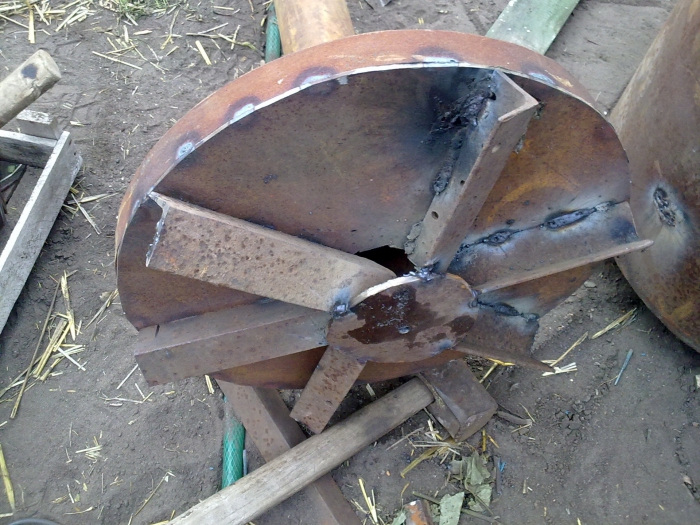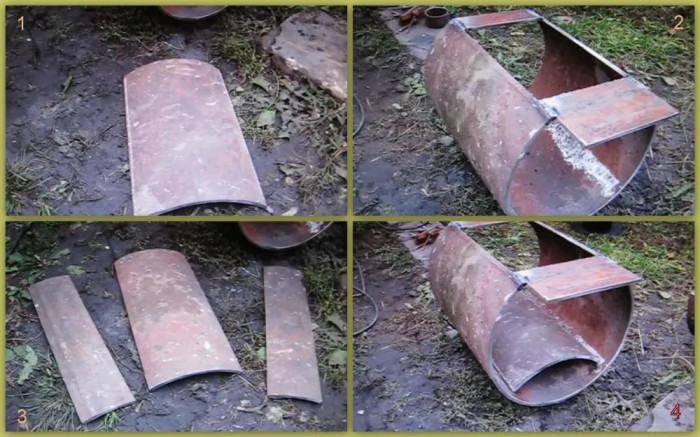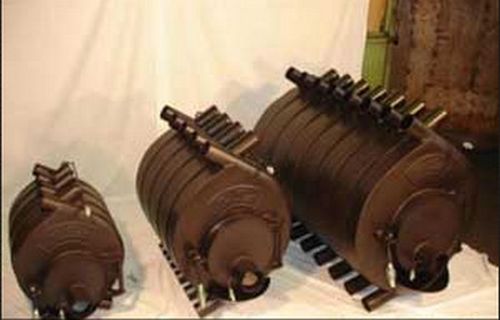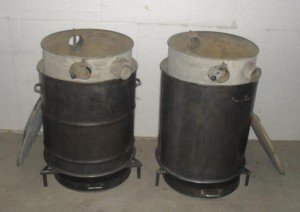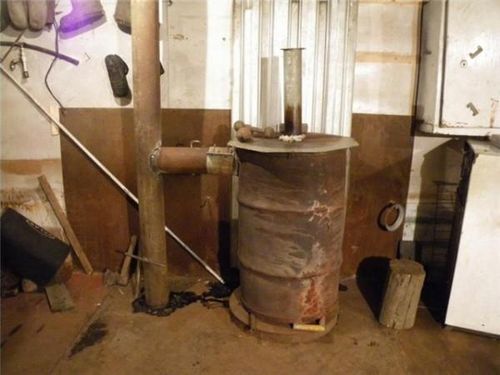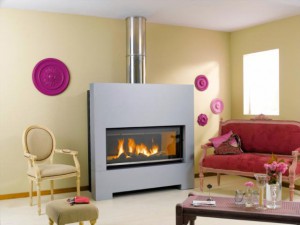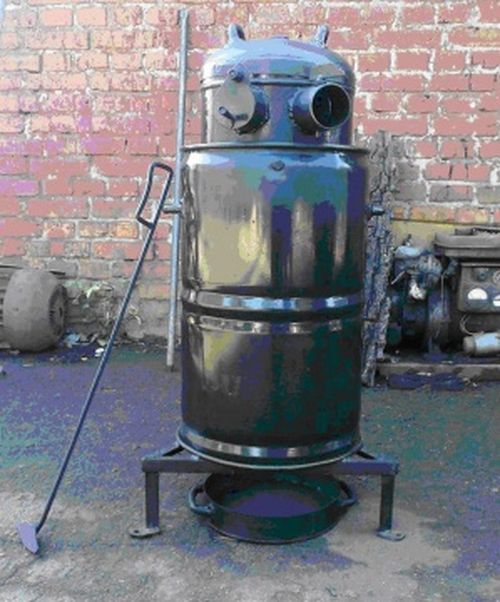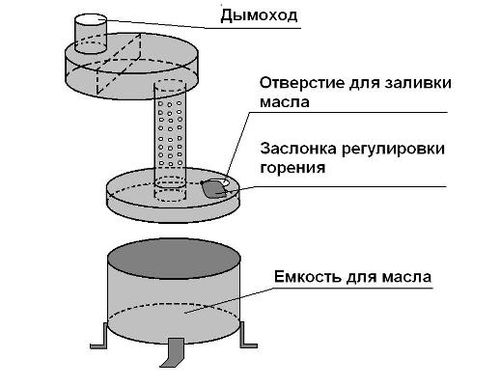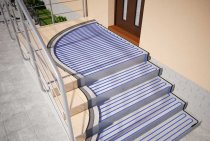Firewood laying and ignition
In order to put firewood into the combustion chamber, it is necessary to lift the press from the outside by the pipe sticking out of the stove. Make a bookmark and set fire to the fuel from above. You can half open the firebox door. In this case, the open end of the 80 mm pipe must be closed, for example, with a small piece of steel sheet. The damper on the chimney opens completely.
In this position, on solid fuel, the stove should work for about twenty minutes so that it warms up well. When all the firewood burns out, it is necessary to remove the remaining fuel and ash from the firebox and make a new bookmark. This firewood is set on fire from above, for this you can use paper, cardboard, dry branches and other materials. As soon as the main fuel flares up, a press is lowered on it, the furnace door is closed, a 80 mm pipe is opened, and the chimney damper is half closed.
Firewood smolders, releasing pyrolysis gas, which, together with a small amount of smoke, passes into the gap between the edges of the press and the walls of the stove. In the second chamber, the gas is mixed with heated air, which enters through the holes made in the 80 mm pipe. Through it, the bulk of the air enters the upper furnace, the minimum - into the zone of smoldering firewood. The air is heated due to the fact that it passes through the pipe, which is located in the heart of the flame obtained from the combustion of pyrolysis gases.
This is one of the easiest designs that you can quickly make with your own hands. For the heating system of a small house - this is the most acceptable option. Practice has shown that one bookmark is enough for 12 hours.
Operating characteristics
The Slobozhanka stove has the following characteristics:
- Long-term combustion, and therefore the supply of heat, is provided for six to twelve hours, everything directly depends on the type of solid fuel used. For example, well-packed sawdust smolders for up to twelve hours, and needles or cones for about six hours;
- The efficiency is about 90%, which ensures the production of thermal energy up to 16.00 kW/h;
- The operation of the furnace is carried out on various solid types of energy carriers of plant origin, and some models operate on waste oil;
- Heating time at full load is about 12 hours;
- Different volume of the combustion chamber. In the event that you use a metal barrel for the body, then 200 liters. That is, you can choose the volume of the combustion chamber, which most closely matches the conditions for heating rooms with different functional purposes and areas;
- High degree of fire safety due to the absence of an open flame and soft burning, fuel smoldering. This allows the use of heating devices of this type in greenhouses (plants can grow half a meter from the stove).
Operation of long-burning furnaces
Heating with conventional stoves is reborn. All this is due to the fact that long-burning stoves have appeared on the market. Their popularity is growing, and the fact is that with the help of these units you can get more thermal energy with lower fuel costs. The efficiency of these devices is 100%, plus less harmful emissions that litter the world around.
To understand how long-burning units differ from conventional heating stoves, it is necessary to recall one school experiment. A match burns faster if its head is pointed down. At the same time, it gives off a small amount of heat. If you hold a match vertically with the head up, then it burns longer, the flame turns blue, and more heat energy is released.
Why is this happening? The thing is that in this position the match burns out from the fire, which goes down, and does not go up, which is much easier. In addition, wood burns slowly, due to which it releases combustible gases called pyrolysis. They, in turn, rising to the fire, burn out, releasing a large amount of heat. Here's a double effect.
Hence the name of the furnaces that use this technology for burning solid fuels. The process itself is called pyrolysis.
Homemade bubafonya of long burning
Cut off the welding seam from the upper end of the barrel with a grinder, align the sharp edges. The result is a cylinder and a lid with a finished flange. Using a hammer or sledgehammer, bend the edges of the cylinder inward. And bend the lid collar outward. Turn the cap over and put it on the cylinder. The lid will sit securely in place without slipping.
Use a chisel to cut a hole for the blowpipe in the center of the cover (for it to pass freely into the hole, it is enough to use a diameter of 102 mm).
Bubafoni assembly diagram.
The hole for the cork on the lid can be tightly welded, but it is better to leave it: looking inside, you can regulate the combustion process.
Then, in the upper part of the barrel, a place is marked for attaching a piece of the chimney pipe.
The intended hole is cut out, and a piece of a chimney pipe 20-25 cm long and 150 mm in diameter is welded. You can install a shut-off damper directly inside the pipe. The body of the stove is ready.
The next in line is the air supply device. For greater rigidity, the edges of the pancake are bent (so that the pancake does not twist from the heat). A hole is cut in the center of the pancake for the blower pipe, and it is welded. If a lid from another barrel is used for a pancake, then the cork hole is tightly welded: during combustion, gases will pass only around the circumference of the pancake. Channels or corners are welded to the pancake from the bottom side. The air supply device is also ready.
It will fit inside the cylinder. At the top of the blower pipe, an adjusting damper of the same diameter as that of the pipe is placed. A threaded pin is welded vertically to the inner wall of the pipe;
After fitting the damper, tighten it with the wing nut. By loosening the nut, moving the damper in relation to the edge of the pipe and tightening the nut back, it will be possible to regulate the flow of air into the furnace.
Install the lid on top - and the whole stove is ready.
It remains to install a pipe for the chimney. Its diameter must be less than 150 mm, otherwise the combustion products will not be completely removed. For good draft, it is better to have a pipe 5 m long. Install it near the stove, preferably on legs. Seal the bottom of the pipe tightly.
Connect the stove end-to-end to the knee, which is welded to the chimney, tighten with a clamp, placing fiberglass under it for tightness. To drain the condensate that collects in the pipe, a ball valve is welded under the elbow of the pipe (it will be possible to clear the blockage with a bar).
This valve is necessary, since when the condensate freezes, the weld can break. Condensate, in addition, can flow into the stove, and through the leaks of the connecting clamp - out.
Now it is already possible to heat the stove “bubafonya”. After removing the cover, pull out the air supply unit. Lay the firewood - at the same time, the height should not exceed the height of the lower edge of the chimney elbow. If you put firewood vertically, then more will come in. Logs can also be chosen large, up to 20 cm in diameter - they will burn without problems.
The top layer is formed from finely chopped chips. A rag or paper is placed on top, poured a little kerosene. Now the firewood is covered with a pancake of the air supply device, the stove cover is strung on top.Opening the blower damper, a piece of lit paper or a rag is thrown inside the air supply pipe (matches quickly go out due to strong draft).
When firewood flares up with a characteristic crackle, the blower damper is completely blocked. Bubafonya in this mode can work without any supervision for days.
This long burning wood stove produces little ash due to the fact that the wood burns almost completely. Ashes can be left uncleaned for a long time.
As you can see, it is quite possible to design the Bubafonya furnaces with your own hands. Many craftsmen make them not only from barrels, but also from old gas cylinders, large fire extinguishers. The main requirement for the future furnace is strong steel walls.
This is how you can make a long-burning stove.
Homemade long-burning stove
We will offer you one of the simplest models that you can do with your own hands. For heating a summer house or a country house, this design is considered simply optimal. The solid fuel model "Stropuva" is taken as the basis for manufacturing.
This is a vertical cylindrical type unit that can be built from a pipe with a diameter of 200 to 500 mm.
Let's start with the preparation of materials:
- pipe 200-500 mm;
- pipe 100 mm;
- pipe 80 mm;
- steel sheet 4 mm thick;
- channel.
Tools
Please note that in order to manufacture a long-burning furnace, you must be a good welder. The level of an amateur is not suitable here. So, the necessary tools:
- electric welding machine;
- gas-burner;
- Bulgarian;
- hammer;
- tape measure and chalk.
Part preparation
First of all, a large pipe is being prepared. It is necessary to make two holes in it with a cutter: one is rectangular for laying firewood, the second on the other side at the top of the stove for a chimney with a diameter of 100 mm. At this stage, it is possible to weld a branch pipe 20-25 cm long from a 100 mm pipe under the chimney to a round hole.
Three pancakes (circles) are cut out of a steel sheet: two with a diameter equal to the outer diameter of a large pipe, one 1 cm smaller than the inner diameter. In one of the large pancakes, a hole of 82-85 mm is made in the middle. A hole of 80 mm is made in a small pancake.
Making a press
In the design of "Stropuva" there is one element, which is called a press. It performs two functions: the first is a separating unit that divides the firebox into two parts, the second - with its help, oxygen is supplied to the combustion chamber where firewood smolders.
It is made from a small pancake, to which an 80 mm pipe is welded. Its length should be enough to protrude beyond the cover of the stove body. In this pipe, closer to the pancake, holes are made with a diameter of 8-10 mm around the perimeter at a height of 20-25 cm.
On the reverse side, four channels are welded crosswise to the pancake
It is important here that they do not cover the hole. With their help, the weight of the press increases, plus with their size they create a gap between the steel circle and the smoldering firewood
In this gap, oxygen will flow from above into the combustion zone through a pipe (essentially telescopic).
Furnace assembly
First, the lower deaf pancake is welded to the body of the stove. Then a press is installed inside the unit with the pipe up. A large pancake with a hole is installed on top. It is simply put on a protruding 80 mm pipe and scalded along the edges of the stove body.
A door is hung on hinges, which can be made from a cut-out part. Only 20 mm corners are welded around the perimeter, and an asbestos cord or strip is necessarily attached under them. This is done to seal the combustion chamber.
Now you need to install the heating unit in the place of the house where you plan to operate it. Connect the chimney and bring it outside.
Please note that long burning wood stoves of this type do not require a vertical chimney. It is better to install the first segment horizontally with a small angle of 3º
Butakov oven
Convection ovens developed by Professor Butakov are widely available on the market and can be used for heating greenhouses, although this option is also used quite rarely.
This heating equipment is produced by various manufacturers, including companies:
- Zubkevich is a developer of furnaces of this type;
- Termofor is one of the largest manufacturers, for which Zubkevich developed the model;
- Teplodar is a clone, although very successful;
- Convection.
Furnaces of various manufacturers have both their advantages and disadvantages. When buying, be guided by the recommendations of experts and reviews.
The principle of operation and functional purpose of this type of heating equipment is fully consistent with Buleryan furnaces.
The body of the stove is a parallelepiped, in which convective air pipes and a two-chamber firebox are located.
Also provided:
- ash pan;
- damper;
- chimney.
Slobozhanka
The stove was named after the historical area where it “was born”. It is a full-fledged heating device with a hob.
According to the principle of operation, the Slobozhanka is similar to the bubaphone, but the air flow here is carried out from the side. Then it is drawn into the perforated casing located inside the housing and rises up. The fuel in this case takes in as much air as is required for smoldering, and the excess moves on.
The air in the Slobozhanka enters all fuel layers, so the pyrolysis process is more active, and the furnace works more efficiently.
Bubafonya
If the above stoves, which support long-term burning, must in most cases be purchased at specialized retail outlets, then the heaters discussed below can be made independently with the necessary materials, tools and skills, which reduces the cost of equipment. In some cases, craftsmen can assemble both Buleryan and Butakov at home, on their knees, but this applies to extreme sports.
Therefore, greenhouses are heated in most cases with home-made stoves that support long-term combustion.
One of the types of such heating equipment is Bubafonya. At its core, this is a convection oven with a body made of a barrel or a gas cylinder, into which various types of solid fuels are placed through the door. An ash pan is provided below. And smoldering is ensured by the fact that from above a constant pressure on burning wood or another type of fuel exerts its own weight on a metal pancake. Thanks to this, greenhouses on one tab can be heated for quite a long time.
Slobozhanka
Greenhouses can also be heated by such a type of convection ovens as Slobozhanka, which are also called "super potbelly stoves".
This oven is made up of:
- combustion chambers;
- air supply and distribution channels;
- convection shirt;
- additional elements (everything directly depends on the design features of a particular model).
The Slobozhanka stove can be purchased in specialized stores or assembled with your own hands, there is nothing complicated about this.
The main difference of this type of long-burning convection ovens is the upper system for ignition and combustion of fuel, and the supply of oxygen from the bottom of the furnace.
In this case, combustion can be:
- top side;
- top center.
We distinguish three main types of Slobozhanka furnaces:
- with L-shaped pipe for lateral supply of oxygen to the combustion chamber;
- with air supply through the central part with the help of a guide pitoid;
- with air supply from the lower side part.
Thus, regardless of the method of supplying air to the combustion chamber, the most efficient heat exchange is ensured.
We also note that installing Slobozhanka stoves in greenhouses is also beneficial for the reason that various materials can be used as fuel, from classic firewood to cones and needles.
As you can see, there are many long-burning stoves that differ in design features, functionality, cost, and a number of other parameters. And we have listed only the main, but not all types of convection, gas-generating heaters that can be used in greenhouses. The choice is yours, we only note that the long-term combustion of fuel, which is provided by furnaces of this type, allows you to maintain a certain temperature regime in greenhouses for a long period of time.
Stove fireplace of long burning
Potbelly stove fireplace Expo
The fireplace attracts with the view of an open fire, and many owners of country houses dream of having it in their living room. But some think about the benefits of such a furnace. The design of a classic English fireplace is based on the principle of long burning and allows the fire in the firebox to glow for a long time. But the efficiency, which does not exceed 50%, and low heat transfer are its significant drawbacks.
Important! Inside the firebox of an English fireplace there is a smoke tooth that affects the internal circulation of air masses and flue gases. It does not allow the incoming air to go up, directing it to the area of laying the logs.
It does not allow the incoming air to go up, directing it to the area of laying the logs.
Another option for a long-burning stove fireplace is the so-called Dutch woman. Before kindling, the blower is closed in it, and the firebox is loaded with firewood only a quarter, without closing the door during combustion. Most of the heated air will still fly through the pipe to the street, but the effect of prolonged contemplation of the fire during the evening will remain indelible.
As a stove, the bubafonya is not perfect, but, using the principles of its design, the craftsmen learned to create more advanced units that allow the fuel to burn out more slowly.
At the heart of the bubafoni is a steel cylinder with incoming and outgoing pipes, as well as a "pancake" located inside in the form of an oppression with blades and an inlet air duct welded to it. As the fuel burns out, the load gradually descends under its own weight. The blades have a curved shape, thanks to which the gases scroll over the pancake several times until they burn out as much as possible.
The chimney for bubafoni is made spasmodic in cross section so that the air that has not reacted with the fuel is not drawn out.
The process of fuel combustion starts from the upper layer, where air enters through the inlet pipe. Then the combustion zone moves lower.
The disadvantage of bubafoni is the impossibility of its operation on coal and pellets, as well as its low efficiency. Adding the following portions of logs to it will not work until the previous ones decay to the end. And the top cover of the stove is not suitable for cooking, like a potbelly stove.
Bubafonya stove from a gas cylinder
Making a long-burning furnace with your own hands from a fifty-liter gas cylinder is presented in the video.
The design of the stove is as simple as possible, it consists of only a few parts: a body, a cover, an air distributor and a chimney. For stability, the oven can be placed on legs from the corner. To remove ash from below, you can make an ash pan with a door.
Another video.
Sequencing
- The remaining gas is released from the gas cylinder and washed several times with water.
- Cut off the top of the balloon. You can make a furnace cover out of it by making a hole with a diameter of 65 mm in the center. The edges of the lid and body of the furnace are ground so that the lid fits tightly onto the body.
- In the upper part of the cylinder, a hole with a diameter of 100 mm is made for the chimney and a pipe section 30-40 cm long is welded horizontally.
- At the bottom of the cylinder, an ash pan cleaning door is made. To do this, cut out a rectangular section of the cylinder body, grind the sections, weld the hinges and install the door on the resulting hole. The door is equipped with a latch.
- The balloon is placed on legs for stability. They can be made from a corner, pipe scraps or a rim. For ease of carrying, bar handles are welded on the sides.
- The critical part of the furnace is the air distributor. It must be heavy enough to effectively clamp sawdust and wood chips, withstand the high temperature of the kiln, and also have diverging blades. They can be made from scraps of a corner. The distributor itself is made of thick-walled steel - at least 6 mm. Cut out a circle with a diameter of 20-40 mm less than the inner diameter of the furnace with a hole in the center. A pipe with a diameter of 60 mm and a height greater than the height of the stove is installed in the hole. Through it, air will flow to the combustion chamber. The blades are welded at the bottom of the disc.
- The body of the stove can be painted with paint based on organosilicon compounds with your own hands, having previously removed scale, rust and dirt from its surface. Any other paint will quickly burn out, as the stove heats up to high temperatures during operation.
The temperature of the walls of the stove from a gas cylinder can heat up to 350 degrees during the fire! Care must be taken to avoid serious burns!
Homemade sawdust stove "Bubafonya" can be equipped with a water circuit. In this case, it is installed in a permanent place. Usually, this stove is used as a mobile one: it can be put in a greenhouse for the time of freezing, it can heat a workshop or a barn in winter, or it can be used to heat a garage. Subject to fire safety requirements, Bubafonya is safe and effective.
Operating principle
The Slobozhanka stove has the following principle of operation. Fuel burns out gradually, starting from the top layer and ending with the lowest, that is, from top to bottom, and not from bottom to top, as in classic stoves.
The air heats up and transfers thermal energy to the walls of the case, rises up, warming the chimney.
The degree of intensity of oxygen supply, and hence the temperature, the intensity of combustion (smoldering) are regulated by dampers, there may be several of them, it all depends on the design features of a particular model.
The combustion chamber has a "jacket" through which cold air is sucked in from below, heats up when passing through and heats the room when leaving the stove, ensuring continuous circulation of air masses. The volume of heated air in most cases is regulated using a reflector cover, which also allows you to adjust the temperature in the room.
From theory to practice
So, let's move from theory to practice. Let's take a model with a central air supply to the combustion chamber.
We need to make a channel for supplying and distributing air. It is made from a thick-walled pipe. Just take a piece of pipe along a length not exceeding the height of the combustion chamber. A bolt must be welded at the bottom. Then cut a nickel out of sheet steel with a diameter equal to the diameter of the pipe, drill a hole and fasten it to the bolt with a nut. It turns out that the pipe in the lower part is closed by a penny that moves along the axis, and the intensity of oxygen supply to the furnace depends on how closed the section is, which means the nature of the combustion of the fuel and the temperature in the room. In the pipe, using an angle grinder, cut grooves for air supply to the furnace with a width of at least 10.00 mm. It is also necessary to weld the circle. To do this, cut a “pancake” out of steel - a circle with a diameter smaller than the diameter of the combustion chamber, cut a hole in the center corresponding to the diameter of the pipe.It remains only to put a circle on the pipe, 20-30 centimeters and weld.
Now let's move on to the body. You can use a gas cylinder, a barrel, or weld a sheet steel cylinder. In a cylinder or barrel, it is necessary to cut off the upper part, and weld the bottom in the cylinder;
A hole for the chimney is cut in the upper side part of the body, with a diameter of at least 100 mm for the removal of combustion products and we weld a pipe of the appropriate diameter;
A hole is cut in the center of the bottom to install the oxygen supply pipe we made. The diameter of the hole is equal to the outer diameter of the pipe, which is installed as an air duct;
We proceed to the manufacture of a heat-dissipating disk. Use sheet steel 10 mm thick. Cut a circle with a diameter slightly smaller than the diameter of the body, you can weld a handle from steel wire or reinforcement for convenience;
Next, we need to make a convection shirt (stove casing). To do this, take sheet steel and weld a cylinder with a diameter that is several centimeters larger than the diameter of the main body of the stove. It is difficult to imagine the Slobozhanka oven without a convection shirt;
We connect the main body and the convection jacket. To do this, cylinders of a solid or tubular type with heads can be used. Make holes with a drill. Then fasten the heads to the rivets with a riveter;
We make a cover for the main body
You can take the cut off top of the cylinder or the lid of the barrel and weld the handles from rebar or large diameter steel wire;
Important condition. The stove must be above the floor at a distance of at least 25 centimeters
This is necessary to ensure air circulation in the convection jacket. Therefore, do not forget to weld the legs, for example, from a corner of the appropriate length to the body.
As you can see, the Slobozhanka stove is assembled on its own not simply, but very simply. The only but, as noted above, heaters of this type can differ significantly in design features, so stick to the selected drawing and the general recommendations indicated in our article.
Materials for the manufacture of a long-burning stove
Long-burning furnaces can be made by hand from sheet metal or various metal structures. Examples and drawings of such stoves are given below.
barrel stove
A do-it-yourself heater designed for heating utility rooms is made of a two-hundred-liter metal barrel. The stove runs on sawdust, shavings and other woodworking waste. A small barrel for loading fuel is installed on a stand inside a large barrel. Under it is an ash pan - a drawer made of sheet metal.
The stove itself is placed on a stand, the role of which is played by a car disk. A smoke branch pipe is made from scraps of a pipe with a diameter of 100-150 mm. The barrel is equipped with a sheet metal lid with a handle and an air inlet.
Inside a small barrel, a log sharpened into a cone is installed, it is indicated in the drawing. Sawdust is piled around it. After tamping, the log is taken out and the sawdust is set on fire. In the process of smoldering, gas is released into the space of a large barrel, where it is afterburned.
Furnace with a water circuit from a metal pipe
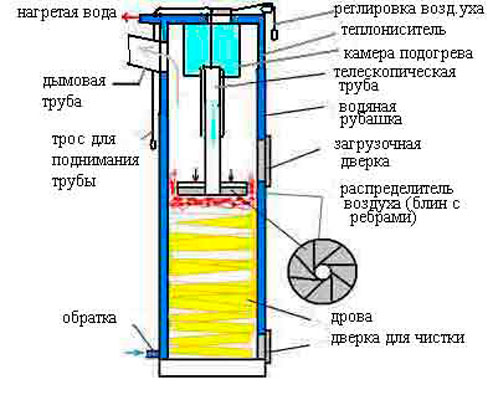
A telescopic hollow pipe is installed in the center of the disc, through which air enters directly into the combustion chamber, where, thanks to the ribs welded onto the disc, it evenly distributes it over the entire surface of the firewood. It goes down on its own as the fuel burns out.You can lift it before loading with a cable.
The loading door is located in the center of the oven. Below is a cleaning door and an ash pan. At the top is a chimney. The stove is equipped with a water circuit with nozzles for water inlet and outlet. Such a stove with a water circuit can quite effectively heat small houses and other premises, and you can make it from improvised materials with your own hands.
Waste Gas Cylinder Furnace
A stove from a gas cylinder can be made without extra costs and finding the right material. The dimensions of a 50-liter cylinder are perfect for making such a stove, and the wall thickness and tightness make it safe to use.
The design of the furnace as a whole does not differ from the previous model, this can be seen in the drawing. A cut-off propane tank is used as the body. Do-it-yourself sheet metal is made with a suitable size cover with a hole for the air distributor pipe. Fuel is loaded through the top, filling the volume of the cylinder almost to the chimney. Such a stove works on sawdust and other waste, as well as on small firewood. The fuel is carefully tamped, ignited with wood chips or an ignition agent and an air distributor is installed, after which it is covered with a lid.
